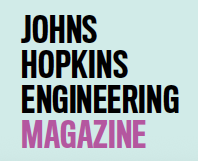“The first month of our project, we looked at all of these crushing mechanisms that work on Earth—and basically had to throw them out,” says Jonik Surprenant, one of four Johns Hopkins mechanical engineering seniors behind the student design “Asteroid Grinder” project. “They don’t work in space.”
Surprenant and classmates Jacob Hammond, Grace Nockolds, and Zahari Stoimenov are developing a prototype device that could one day support construction in space for deeper explorations. Their senior design project is backed by Karman+, a young aerospace company focused on mining asteroids for raw materials.
The students’ challenge: Build a compact, energy- efficient device designed to work aboard a spacecraft, pulverizing asteroid rocks— known as regolith—into fine, uniform powder. That powder could be transformed into satellite fuel, building materials, or solar panel components—avoiding the high cost and energy intensive process of hauling raw materials from Earth.
Once the realm of science fiction, asteroid mining is edging closer to reality. NASA and Japan’s space agency have already returned samples from asteroids, and commercial missions aren’t far behind. Karman+ plans to launch its first mission in 2027 to collect raw materials from asteroids, with later missions aiming to process the regolith onboard the spacecraft itself.
“As a company, we aim to deliver asteroid regolith to supply the space economy,” says Jesse Miller, Engr ’18, who now works as an engineer at Karman+ and has advised the students throughout the project. “But first, we need to grind it—and that’s where this project at Hopkins comes in.”
The students’ design, which they’ve nicknamed “Wall-E,” is a foot-long cube, a system of spinning blades and mechanical pressure that pushes asteroid rocks through the machine without relying on gravity. Regolith enters through a compact accordion-style “gateway,” then feeds into a spinning grinder inspired by an ice shaver. The resulting dust is sieved and stored, ready for future use.
One of the team’s most inventive ideas was designing a three-axis rotating frame that simulates the chaos of a microgravity environment. “That was one of the defining moments for me,” says Rich Bauernschub, who co-leads the mechanical engineering senior design course. “They had this eureka sort of presentation.”
The device isn’t meant to fly just yet, but Karman expects it to directly inform the version they hope to launch on their future asteroid missions. For the company, it’s valuable research bringing them closer to a final design. For the students—who are all busy varsity athletes—it’s hands-on, high-stakes engineering work. “We’re not just building a gadget—we’re defining a process,” says Nockolds. “It’s real engineering, with a real client, working on some- thing no one’s done before.”
Miller says that returning as a mentor has been a full-circle moment. “I remember my own senior design project as the most valuable experience of my time at Hopkins,” he says. “It’s just awesome to watch this teamwork.”
— KATIE PEARCE


